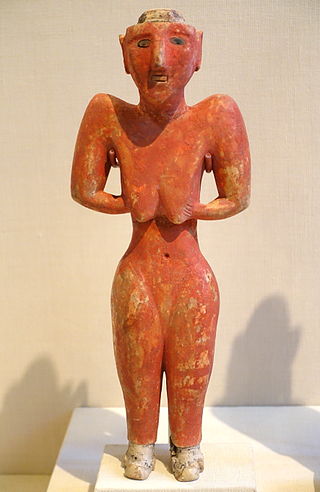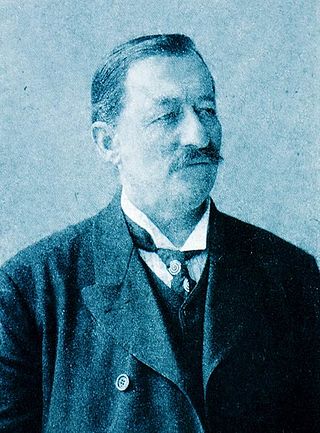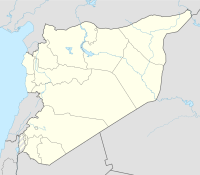Uruk, known today as Warka, was an ancient city in the Near East, located east of the current bed of the Euphrates River, on an ancient, now-dried channel of the river. The site lies 93 kilometers northwest of ancient Ur, 108 kilometers southeast of ancient Nippur, and 24 kilometers southeast of ancient Larsa. It is 30 km (19 mi) east of modern Samawah, Al-Muthannā, Iraq.

Waššukanni or Aššukanni was the capital of the Hurrian kingdom of Mitanni, from around 1500 BC to the 13th century BC.
Shuruppak, modern Tell Fara, was an ancient Sumerian city situated about 55 kilometres (35 mi) south of Nippur and 30 kilometers north of ancient Uruk on the banks of the Euphrates in Iraq's Al-Qādisiyyah Governorate. Shuruppak was dedicated to Ninlil, also called Sud, the goddess of grain and the air.

Tell Halaf is an archaeological site in the Al Hasakah governorate of northeastern Syria, a few kilometers from the city of Ras al-Ayn near the Syria–Turkey border. The site, which dates to the sixth millennium BCE, was the first to be excavated from a Neolithic culture, later called the Halaf culture, characterized by glazed pottery painted with geometric and animal designs.

Theodor Wiegand was a German archaeologist.

Tell Fekheriye is an ancient site in the Khabur river basin in al-Hasakah Governorate of northern Syria. It is securely identified as the site of Sikkan, attested since c. 2000 BC. While under an Assyrian governor c. 1000 BC it was called Sikani. Sikkan was part of the Syro-Hittite state of Bit Bahiani in the early 1st millennium BC. In the area, several mounds, called tells, can be found in close proximity: Tell Fekheriye, Ras al-Ayn, and 2.5 kilometers east of Tell Halaf, site of the Aramean and Neo-Assyrian city of Guzana. During the excavation, the Tell Fekheriye bilingual inscription was discovered at the site, which provides the source of information about Hadad-yith'i.

Šamuḫa is an ancient settlement near the village of Kayalı Pinar, c. 40 km west of Sivas, in the Sivas Province of Turkey. Located on the northern bank of Kizil Irmak river, it was a city of the Hittites, a religious centre and, for a few years, a military capital for the empire. Samuha's faith was syncretistic. Rene Lebrun in 1976 called Samuha the "religious foyer of the Hittite Empire".
Stefan Heidemann is a German orientalist at Hamburg University, Hamburg.
Kisurra was an ancient Sumerian tell situated on the west bank of the Euphrates, 7 kilometres (4.3 mi) north of Shuruppak and due east of Kish.

Amlah or ʿAmlāʾ, al-Dhāhirah province, Sultanate of Oman. The area around Amlah contains numerous archaeological sites which came to light during surveys in the mid 1970s. Those that are available to the public date from the Bronze Age Wadi Suq period to the late pre-Islamic period. 26 excavated graves provide evidence for a cemetery at al-Fuwaydah. The graves and grave goods are related most closely to those of the United Arab Emirates, Preislamique Récente, i.e. PIR, and not the Samad Late Iron Age. Among the most striking Late Iron Age finds are bronze phiales inscribed on the inside.
Tell Chuera is an ancient Near Eastern tell site in Raqqa Governorate, northern Syria. It lies between the Balikh and Khabur rivers.

Gottlieb Schumacher was an American-born civil engineer, architect and archaeologist of German descent, who was an important figure in the early archaeological exploration of Palestine.
Tuttul was an ancient Near East city. Tuttul is identified with the archaeological site of Tell Bi'a in Raqqa Governorate, Syria. Tell Bi'a is located near the modern city of Raqqa and at the confluence of the rivers Balikh and Euphrates.
Stefan Clessin was a German malacologist.
The Deutsche Orient-Gesellschaft, abbreviated DOG, is a German voluntary association based in Berlin dedicated to the study of the Near East.
Habuba Kabira is an ancient Near East archaeological site on the west bank of the Euphrates River in Aleppo Governorate, Syria, founded during the later part of the Uruk period in the later part of the 4th millennium BC. It was about 1300 kilometers from the southern Mesopotamia city of Uruk, five kilometers north of Tell Halawa, ten kilometers south of Mumbaqat, and eight kilometers upstream from Jebel Aruda. The site was excavated as part of a rescue archaeology effort due to the construction of the Tabqa Dam and is now mostly underwater. The Habuba Kabira complex consists of two sites
Winfried Orthmann was a German archaeologist who specialised in the Near East regions.

Sirkeli Höyük is one of the largest tells of Cilicia with an area of approximately 80 ha. It is 40 kilometers east of the city of Adana, northwest of the village Sirkeli in the district of Ceyhan, at the breakthrough of the Ceyhan through the Misis Mountains.
Tall Bazi, is an ancient Near East archaeological site in Raqqa Governorate of Syria in the same general area as Mari and Ebla. It is located on the east bank of Euphrates river in upper Syria, about 60 kilometers south of Turkey border. It is considered a twin site to the adjacent Tell Banat Complex. Both were occupied in the 3rd and 2nd millennium BC with Banat being the focus in the early part and Bazi in the later. Tall Bazi has been proposed as the location of Armanum, known from texts of Sargon and Naram-Sin in the Akkadian period, during the reign of Naram-Sin of Akkad. It was occupied into the Mitanni period, with an occupational gap after c. 2300 BC, at which time it was destroyed. In the Late Roman Empire a large building was constructed at the top of the main mound, using the remaining Late Bronze Age fortification walls.
Julius Johann Heinrich Jordan was a German archaeologist active in Mesopotamia before and after the First World War.








